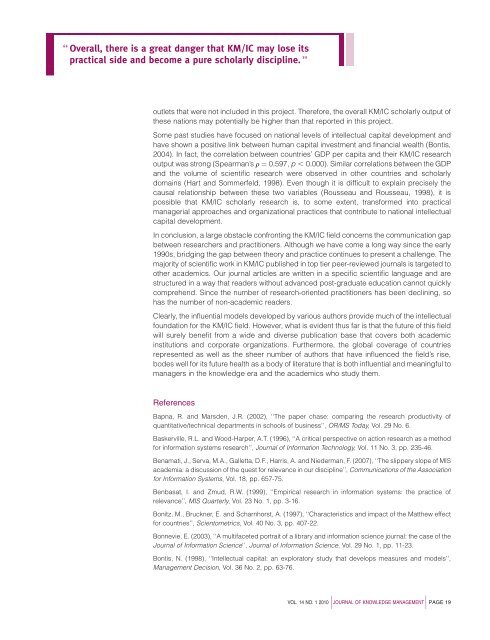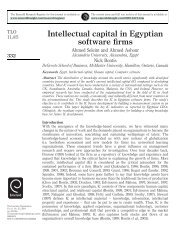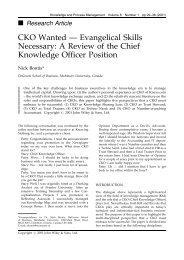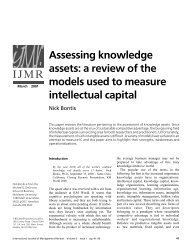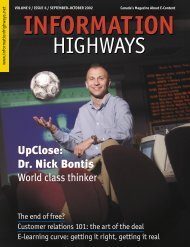A scientometric analysis of knowledge management and ... - Emerald
A scientometric analysis of knowledge management and ... - Emerald
A scientometric analysis of knowledge management and ... - Emerald
Create successful ePaper yourself
Turn your PDF publications into a flip-book with our unique Google optimized e-Paper software.
‘‘ Overall, there is a great danger that KM/IC may lose its<br />
practical side <strong>and</strong> become a pure scholarly discipline. ’’<br />
outlets that were not included in this project. Therefore, the overall KM/IC scholarly output <strong>of</strong><br />
these nations may potentially be higher than that reported in this project.<br />
Some past studies have focused on national levels <strong>of</strong> intellectual capital development <strong>and</strong><br />
have shown a positive link between human capital investment <strong>and</strong> financial wealth (Bontis,<br />
2004). In fact, the correlation between countries’ GDP per capita <strong>and</strong> their KM/IC research<br />
output was strong (Spearman’s r ¼ 0:597, p , 0:000). Similar correlations between the GDP<br />
<strong>and</strong> the volume <strong>of</strong> scientific research were observed in other countries <strong>and</strong> scholarly<br />
domains (Hart <strong>and</strong> Sommerfeld, 1998). Even though it is difficult to explain precisely the<br />
causal relationship between these two variables (Rousseau <strong>and</strong> Rousseau, 1998), it is<br />
possible that KM/IC scholarly research is, to some extent, transformed into practical<br />
managerial approaches <strong>and</strong> organizational practices that contribute to national intellectual<br />
capital development.<br />
In conclusion, a large obstacle confronting the KM/IC field concerns the communication gap<br />
between researchers <strong>and</strong> practitioners. Although we have come a long way since the early<br />
1990s, bridging the gap between theory <strong>and</strong> practice continues to present a challenge. The<br />
majority <strong>of</strong> scientific work in KM/IC published in top tier peer-reviewed journals is targeted to<br />
other academics. Our journal articles are written in a specific scientific language <strong>and</strong> are<br />
structured in a way that readers without advanced post-graduate education cannot quickly<br />
comprehend. Since the number <strong>of</strong> research-oriented practitioners has been declining, so<br />
has the number <strong>of</strong> non-academic readers.<br />
Clearly, the influential models developed by various authors provide much <strong>of</strong> the intellectual<br />
foundation for the KM/IC field. However, what is evident thus far is that the future <strong>of</strong> this field<br />
will surely benefit from a wide <strong>and</strong> diverse publication base that covers both academic<br />
institutions <strong>and</strong> corporate organizations. Furthermore, the global coverage <strong>of</strong> countries<br />
represented as well as the sheer number <strong>of</strong> authors that have influenced the field’s rise,<br />
bodes well for its future health as a body <strong>of</strong> literature that is both influential <strong>and</strong> meaningful to<br />
managers in the <strong>knowledge</strong> era <strong>and</strong> the academics who study them.<br />
References<br />
Bapna, R. <strong>and</strong> Marsden, J.R. (2002), ‘‘The paper chase: comparing the research productivity <strong>of</strong><br />
quantitative/technical departments in schools <strong>of</strong> business’’, OR/MS Today, Vol. 29 No. 6.<br />
Baskerville, R.L. <strong>and</strong> Wood-Harper, A.T. (1996), ‘‘A critical perspective on action research as a method<br />
for information systems research’’, Journal <strong>of</strong> Information Technology, Vol. 11 No. 3, pp. 235-46.<br />
Benamati, J., Serva, M.A., Galletta, D.F., Harris, A. <strong>and</strong> Niederman, F. (2007), ‘‘The slippery slope <strong>of</strong> MIS<br />
academia: a discussion <strong>of</strong> the quest for relevance in our discipline’’, Communications <strong>of</strong> the Association<br />
for Information Systems, Vol. 18, pp. 657-75.<br />
Benbasat, I. <strong>and</strong> Zmud, R.W. (1999), ‘‘Empirical research in information systems: the practice <strong>of</strong><br />
relevance’’, MIS Quarterly, Vol. 23 No. 1, pp. 3-16.<br />
Bonitz, M., Bruckner, E. <strong>and</strong> Scharnhorst, A. (1997), ‘‘Characteristics <strong>and</strong> impact <strong>of</strong> the Matthew effect<br />
for countries’’, Scientometrics, Vol. 40 No. 3, pp. 407-22.<br />
Bonnevie, E. (2003), ‘‘A multifaceted portrait <strong>of</strong> a library <strong>and</strong> information science journal: the case <strong>of</strong> the<br />
Journal <strong>of</strong> Information Science’’, Journal <strong>of</strong> Information Science, Vol. 29 No. 1, pp. 11-23.<br />
Bontis, N. (1998), ‘‘Intellectual capital: an exploratory study that develops measures <strong>and</strong> models’’,<br />
Management Decision, Vol. 36 No. 2, pp. 63-76.<br />
VOL. 14 NO. 1 2010 j j JOURNAL OF KNOWLEDGE MANAGEMENT PAGE 19


